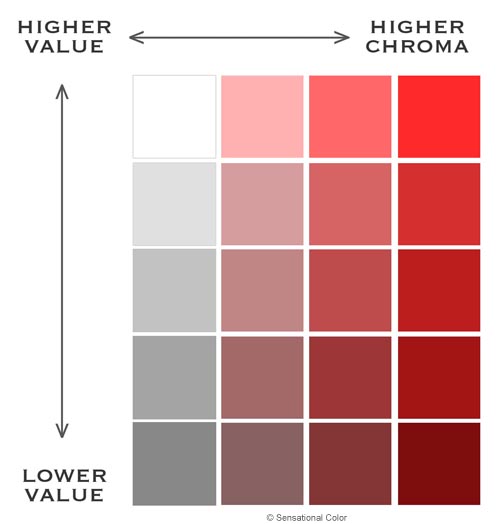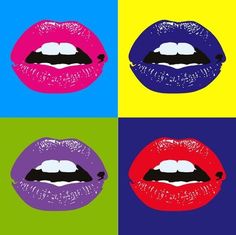Warm up activities....
1. Match the following sentences:
| 1. Blue is a… |
a. emotions.
|
| 2. Red is a… |
b. warm colour.
|
| 3. Colour schemes express… |
c. use black and white in different proportions
|
| 4. Achromatic schemes… |
d. harmonising.
|
| 5. Polychrome images… |
e. have a single colour.
|
6. Monochrome images…
|
f. use neighbouring colours in the colour wheel.
|
7.Combining colours is called colors…
|
g. have two or more colours.
|
8. Related colour harmonies…
|
h. cold colour.
|
2. Work in pairs. Discuss these questions with your partner.
- What is related color harmony? What is complementary colour harmony?
- What is harmony of greys? Is it a warm range or a cold one?
- Explain:
- monochrome images
- polychrome images
- achromatic scheme
- Hue
- Value
- Saturation
3. True or false? Correct the false sentences.
- Colours have five characteristics.
- Hue, tone and tint refer to the name of the color.
- Value is the luminosity of a colour.
- Value represents the amount of water in a color.
- A tone with a lot of white, has a low value.
- A tone with a lot of black, has a low value.
- Only primary colours are pure colours.
- We always perceive colors in the same way.

COLOURS
Primary and secondary colours
Colour is an element of visual language has been studied throughout history to produce a series of
basic colours that mix in different quantities, and by adding white or black, can imitate with some
perfection the colours that we see in reality.
Primary colours
The three basic colours cannot be obtained by mixing any other colour. They are called primary
colours and are: yellow, cyan and magenta.
Secondary colours
If we mix two primary colours we obtain secondary, or binary, colours. They are: red, green, and violet.
Subtractive colour mixing
When we mix all the primary colours we produce a visual sensation close to black. This is called
subtractive colour mixing, because it implies that each added colour subtracts luminosity from the
whole.
The colour wheel and complementary colours
The colour wheel is a framework used for sorting primary and secondary colours, facilitating their
visual understanding. Contrasting colours in the colour wheel are called complementary colours.
A colour is complementary to another when it does not contain any amount of the opposite
colour. For example, yellow is complementary to violet because it contains no blue or magenta,
which are the colours that make up violet.
Characteristics of colours
• Hue
The tone, hue, or tint is the specific name given to each colour. It is the characteristic used to
identify the colour, regardless of its composition.
• Value
obtained by adding white to a tone and darkness by adding black. When a tone has a lot of white,
it has a high value. If it has a lot of black, it has a low value.
• Saturation

Saturation refers to the grade of purity, vivacity or intensity of a colour. Primary and secondary
colours are pure colours, they have a maximum grade of saturation.
Both in nature and in graphic reproductions colours rarely appear with their maximum grade
of saturation. Normally they are complex mixes of colours with their respective complementary
colours.
The more complementary colour in the mix, the less saturation the original colour will have.
Perception of colour
Our sight can perceive the same colour in a different way depending on lighting, the space it
occupies or the colours that surround it.
The Colour range

A colour range orders colours according to their value, saturation or the position of their tones in
the colour wheel.
• Cold range: Tones that go from green to purple. Blue is the coldest colour.
• Warm range: Tones that go from magenta to greenish yellow. Red is the warmest colour.
Expressiveness of colour schemes
Cold colours are associated with calm, or seriousness and warm colours with joy, or aggressiveness.
Achromatic scheme
This range uses black and white, that, in different proportions, give different values of clarity and
darkness. This range is cold.
Polychrome and monochrome
Polychromatic images have two or more colours, with different values and saturation.
Monochrome images have a single colour and different values.
Combining colours is called harmonising. We harmonise related colours, complementary colours and colours with black and white, creating greys.
Related colour harmonies
Using neighbouring colours in the colour wheel creates a harmony of related colour.
To separate forms, we use colours that contrast in the colour wheel. For example, magenta and green. This creates a harmonious contrast.
Harmony of greys
By mixing colours with black and white, we obtain a harmony of greys. Similar colours produce a harmony of similar greys.
Complementary colours, produce a harmony of complementary greys.
http://www.slideshare.net/darakeyla/cool-and-warm-colors
Try this link, there you´d find more information about colours...
Exercises
True or false? Correct the false sentences.
1. Colours have five characteristics.
2. Hue, tone and tint refer to the name of the colour.
3. Value is the luminosity of a colour.
4. Value represents the amount of water in a colour.
5. A tone with a lot of white, has a low value.
6. A tone with a lot of black, has a low value.
7. Only primary colours are pure colours.
8. We always perceive colours in the same way.
Complete the spaces.
1. Colour is an element of … language. a) visual b) oral
2. There are … primary colours. a) two b) three
3. Primary colours are … by mixing other colours. a) obtained b) not obtained
4. Red, green and violet are … colours. a) secondary b) primary
5. Mixing all the primary colours produces… a) near white. b) near black.
6. Subtractive colour mixing implies that
each added colour… luminosity. a) adds luminosity. b) subtracts
each added colour… luminosity. a) adds luminosity. b) subtracts
7. The colour wheel helps us to sort … colours. a) primary b) primary and secondary
8. Yellow is complementary to violet because
it ….colours that form violet. a) contains b) doesn’t contain
it ….colours that form violet. a) contains b) doesn’t contain
Work in pairs. Discuss these questions with your partner.
- Look at the following images, which feelings do
they transmit to you?

-







Great with detailed information. It is really very helpful for us.
ResponderEliminarVillage Talkies a top-quality professional corporate video production company in Bangalore and also best explainer video company in Bangalore & animation video makers in Bangalore, Chennai, India & Maryland, Baltimore, USA provides Corporate & Brand films, Promotional, Marketing videos & Training videos, Product demo videos, Employee videos, Product video explainers, eLearning videos, 2d Animation, 3d Animation, Motion Graphics, Whiteboard Explainer videos Client Testimonial Videos, Video Presentation and more for all start-ups, industries, and corporate companies. From scripting to corporate video production services, explainer & 3d, 2d animation video production , our solutions are customized to your budget, timeline, and to meet the company goals and objectives.
As a best video production company in Bangalore, we produce quality and creative videos to our clients